Dashrath Mahal Is A Top Destination For Your To Visit In Ayodhya In 2026
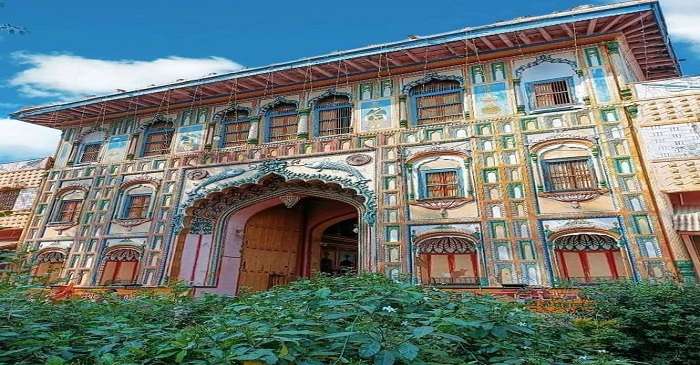
Dashrath Mahal is a beautiful palace in the heart of Ayodhya, it’s the place where Lord Ram and his family lived most of their life. Inside the mahal, there’s a shrine of Lord Rama, Lakshman, and Devi Sita.
Their presence in this historic monument brings together the divine and legendary heritage of Ayodhya’s spiritual and historical landscape. One can find saffron-clothed monks singing and reciting mantras inside the mahal. The Dashrath Bhavan is decorated well during celebrations and festivals like Ram Vivah, Diwali, Shravan Mela and Ram Navami.
Dashrath Mahal History

As per Ramayan, Lord Ram and his siblings spent their entire childhood and youth in this mahal/bhavan. The Bhavan comprises a shrine with Shri Ram, Devi Sita and Laxman’s idols. The temple is fairly accessible, with a wide and colourful entrance. You will be swayed by intense religious feelings whenever you visit the property. King Dasaratha had Ayodhya as the capital of his kingdom. Here, Sri Rama, together with his three brothers Laxman, Bharath and Shatrughna, lived a major part of their childhood.
In current times, you can find saints and devotees dressed in saffron robes who sing and recite the lines and chaupaiyas from Ramayana and many other scriptures. Even though the mahal is much smaller than its real structure where King Dasrath originally may have lived, Dashrath Mahal Ayodhya still attracts large crowds of tourists and devotees who come here to witness the spot where their beloved Rama was born and lived his childhood.
Also Read: Places To Visit In Allahabad
Dashrath Mahal Location
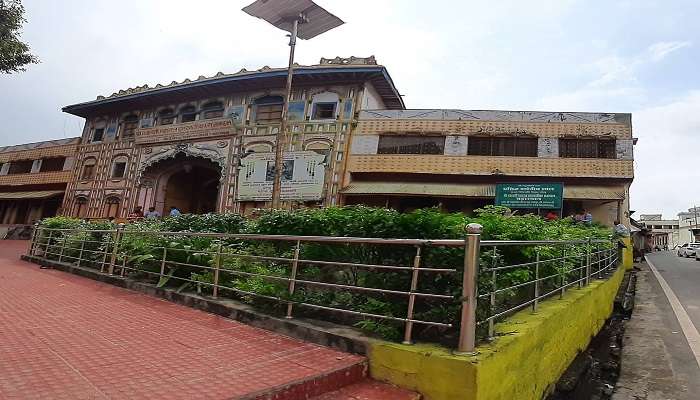
It is situated in the middle of Ayodhya in the Faizabad district of Uttar Pradesh and is largely accessible through the convenient network of roads within the city. This brings in more visitors to explore the historical and traditional spots of the place. It is believed to be constructed in the exact spot where the original palace stood. Dasaratha Mahal is also popularly known as Dashrath Bhavan and Badi Jagah.
Dashrath Mahal Timings

The Dashrath Mahal timings for darshan are divided into two slots to accommodate tourists throughout the day. These timings ensure that tourists can plan their visit accordingly. Arriving early is recommended, especially during weekends and festivals, to avoid long queues. Morning visits often offer a more peaceful experience, while evening visits provide the chance to glimpse the Mahal’s shining spectacle under the lights.
- Morning Timing: 8:00 AM to 12:00 PM
- Evening Timing: 4:00 PM to 10:00 PM
Related Post: Things To Do In Varanasi
Dashrath Mahal Activities
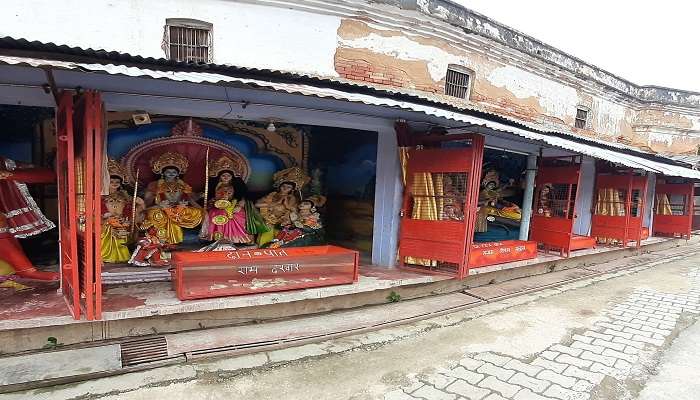
As you spend time exploring the palace, you will be attracted by its beautiful entrance decorated with fine paintings. You can view the celebrations going on Inside as saffron-clothed monks sing and chant songs and mantras. Dashrath Mahal Ayodhya is quite small when compared to other magnificent palaces, but it has its beauty mixed with the charm of the history of Lord Ram being attached to it. The mahal comes alive in various festivals like Ram Vivah, Shravan Mela, Karthik Mela, Ram Navami and Diwali.
Close to the Dashrath Mahal, you will find a variety of shopping centres and stores that sell great souvenirs and merchandise. From interesting themes to luxury designs, this shopping experience is a tourist treasure trove. Do not forget to try out the local cuisine there too. A nearby restaurant serves decadent food that will immediately end all your cravings after a long day of sightseeing.
Places To Visit Near Dashrath Mahal
Read about the top places to explore near the Dashrath Mahal and visit the famous sites. The details are following.
1. Hanuman Garhi Mandir
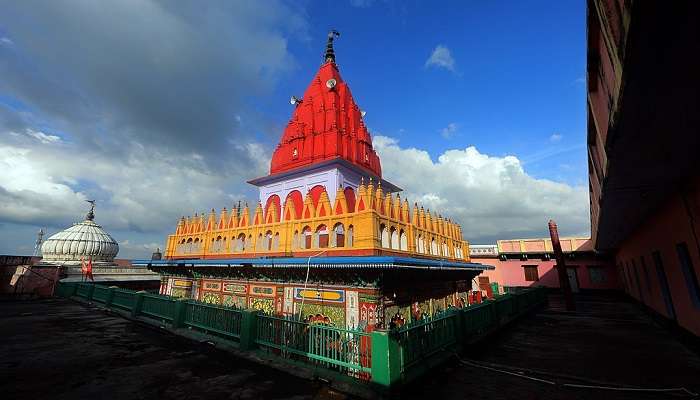
It is dedicated to Lord Hanuman, an old religious site in Naimisharanya. People also call the temple Bade Hanuman since it features a giant, 12 ft statue of Hanuman. Another one you can find here is the massive stone idol of Lord Hanuman as he carries Lord Rama and Lakshman on his mighty shoulders. The temple also boasts a peaceful ambience that tourists like to imbibe. The Hanuman Garhi Mandir is also called Dakshineshwar Temple since the deity faces the Dakshin (south direction).
- Location: Ayodhya, Uttar Pradesh, near the Ram Janmabhoomi
- Timing: Open 24 hours
Related Post: Waterfalls Near Varanasi
2. Tulsi Udyan

Tulsi Udyan is a scenic garden and is one of the top places to visit during your time in Ayodhya. This garden was first set up as a memorial to the great saint Tulsi Das, a true devotee of Lord Hanuman and the curator of the epic ‘Ramcharitmanas’. This garden was earlier known as Victoria Park and then, in 1960, Tulsi Udyan. Tulsi Das’s statue is also under a canopy inside the garden. Tourists often like to take a stroll in Tulsi Udyan since it has become a major part of tourism in Ayodhya.
- Location: Faizabad Rd, Tulsi Nagar, Ayodhya, Uttar Pradesh
- Timing: 5 AM to 8 PM
3. Ram Janbhoomi Mandir
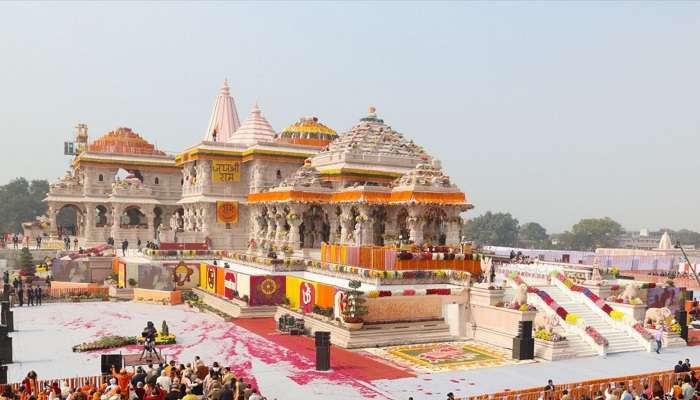
The Ram Mandir is a Hindu temple in the city of Ayodhya in Uttar Pradesh. It is said that the temple is situated at the real site of Ram Janmabhoomi, the birthplace of Lord Rama. This temple was re-established on 22 January 2024, followed by a prana pratishtha (consecration) ceremony. On the first day itself, the temple welcomed over half a million devotees and visitors, and after only a month, the average number of visitors crossed around 1 to 1.5 lakh daily.
- Location: Near Ayodhya Railway Staion, Ramkot, Sai Nagar, Ayodhya, Uttar Pradesh
- Timing: 7 AM to 12 PM and 1:30 PM to 9 PM
Related Post: Hotels In Ayodhya
4. Kanak Bhawan
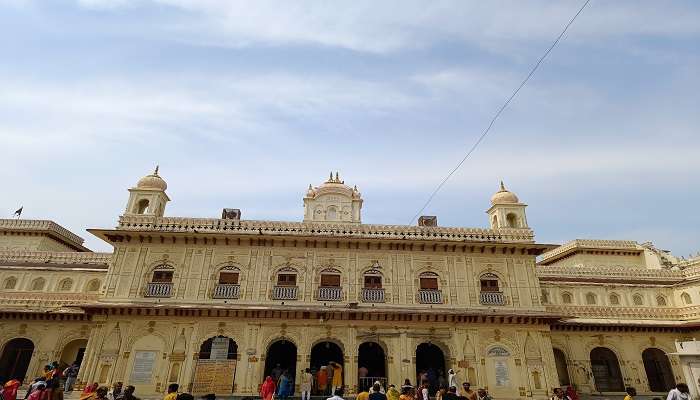
It is another beautiful temple in Ayodhya and is one of the most popular temples in the city. It is said that this temple was a gift from Kaikeyi in the marriage of Rama with Sita, and it belongs to them. According to mythology, after the real Kanak Bhawan was destroyed, it was again built in Dwapar Yug by Lord Krishna himself. Later, it was renovated by King Vikramaditya during the medieval period. After this, it was renovated by Queen Vrishabhanu Kunwari.
- Location: Tulsi Nagar, Ayodhya, Uttar Pradesh
- Timing: 8 AM to 11 PM and 4:30 PM to 9 PM
Dashrath Mahal Travel Routes
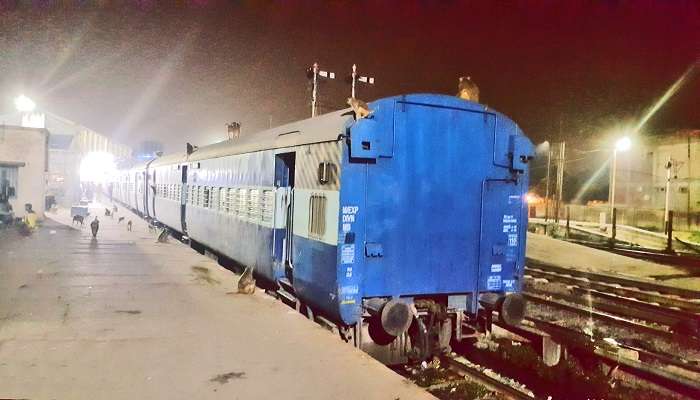
- By Air—The nearest airport to Dashrath Mahal Ayodhya is Maharishi Valmiki International Airport in Varanasi, from where you can hail a taxi or rent a private car.
- By Road—Buses, taxis, and private cars can easily reach Dashrath Mahal since the roads are very accessible from any part of Uttar Pradesh.
- By Train – The nearest stations to Dashrath Mahal are Faizabad and Ayodhya, which are well-connected to other major cities in India.
You May Also Like To Read: Hill Stations Near Uttar Pradesh
Now that you have everything you need to know about Dashrath Mahal, it is time to execute your exciting plans for the next amazing trip to Uttar Pradesh Book your tickets now and get a memorable visit to the spiritual place of Lord Ram for eternal peace and happiness.
For our editorial codes of conduct and copyright disclaimer, please click here.
Cover Image Source:Facebook
Frequently Asked Questions About Dashrath Mahal
What is the usual weather in Ayodhya?
The moderate season in Ayodhya lasts from April to June. July and September are considered off-season to visit here since the state experiences extremely heavy rainfall. The wet heights and slippery terrain do not allow for enough outdoor activities but the city does become quite beautiful and refreshing during the monsoon.
Is there any entry fee to enter Dashrath Mahal?
There is no entry fee and it is absolutely free for anyone to visit Dashrath Mahal. However, you can donate some money at the donation box available in the Mahal.
What is the local food of Ayodhya that every tourist must try?
Ram Ladoo and Ayodhya Chaat are two very popular dishes in Ayodhya that every tourist must try.
How much time does it take to cover the premises?
It takes approximately 1 to 2 hours to cover the entire premises. You can also take some more time to learn about the Mahal in detail.
What to wear when in Ayodhya?
Since Ayodhya features major temples and religious sites, it is advisable to wear appropriate formal or Indian clothes there.
People Also Read:
Kanak Bhawan Ayodhya Ram Mandir Naya Ghat

Unveil the hidden treasures of the globe and turn every travel dream into reality. As a Content Writer, I am passionate enough to craft stories from ancient wonders to modern marvels. My words paint the picture-perfect itinerary for unforgettable experiences. Let my words be your trusted guide to immerse in the diverse culture and discover the beauty of the unknown.











